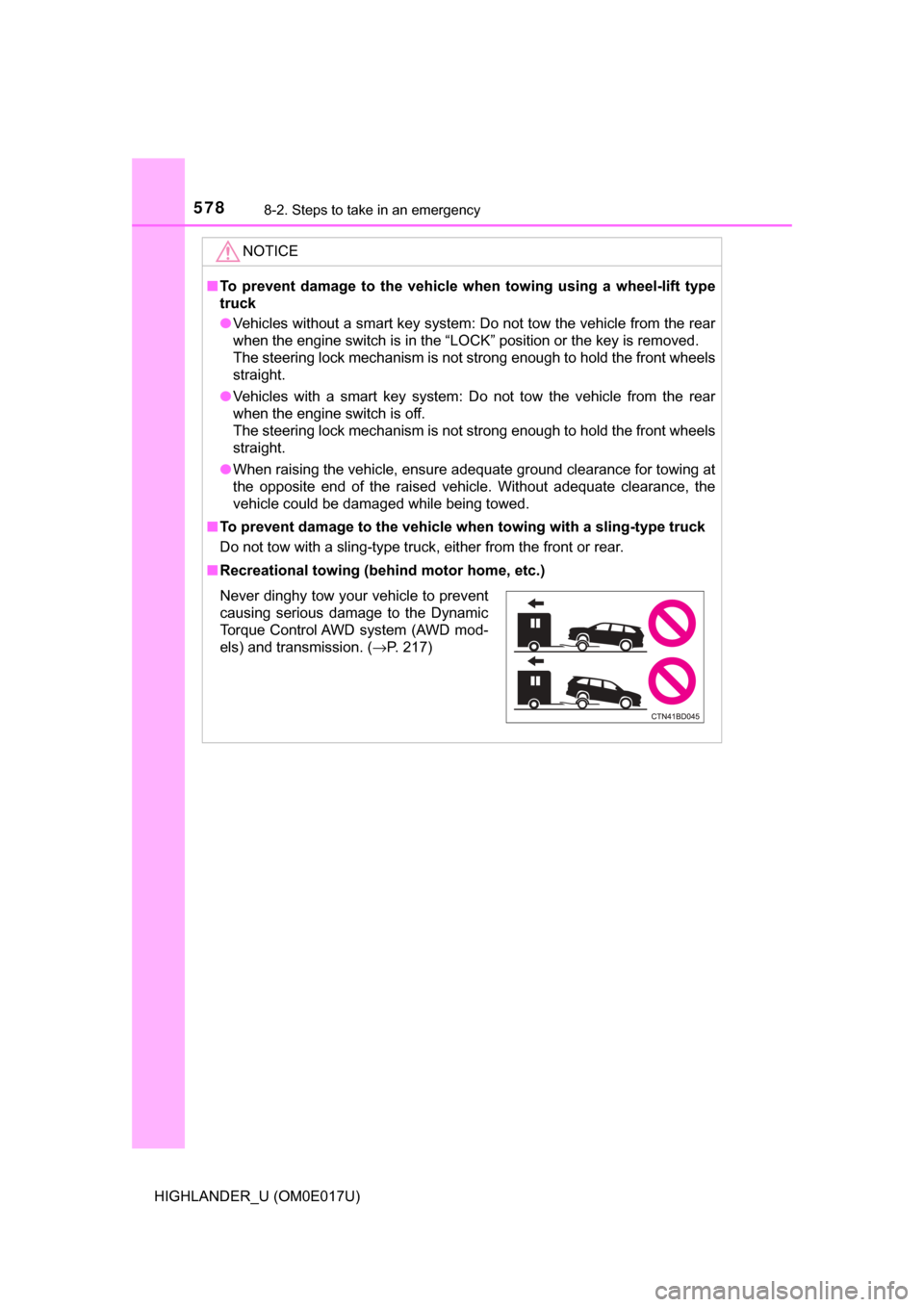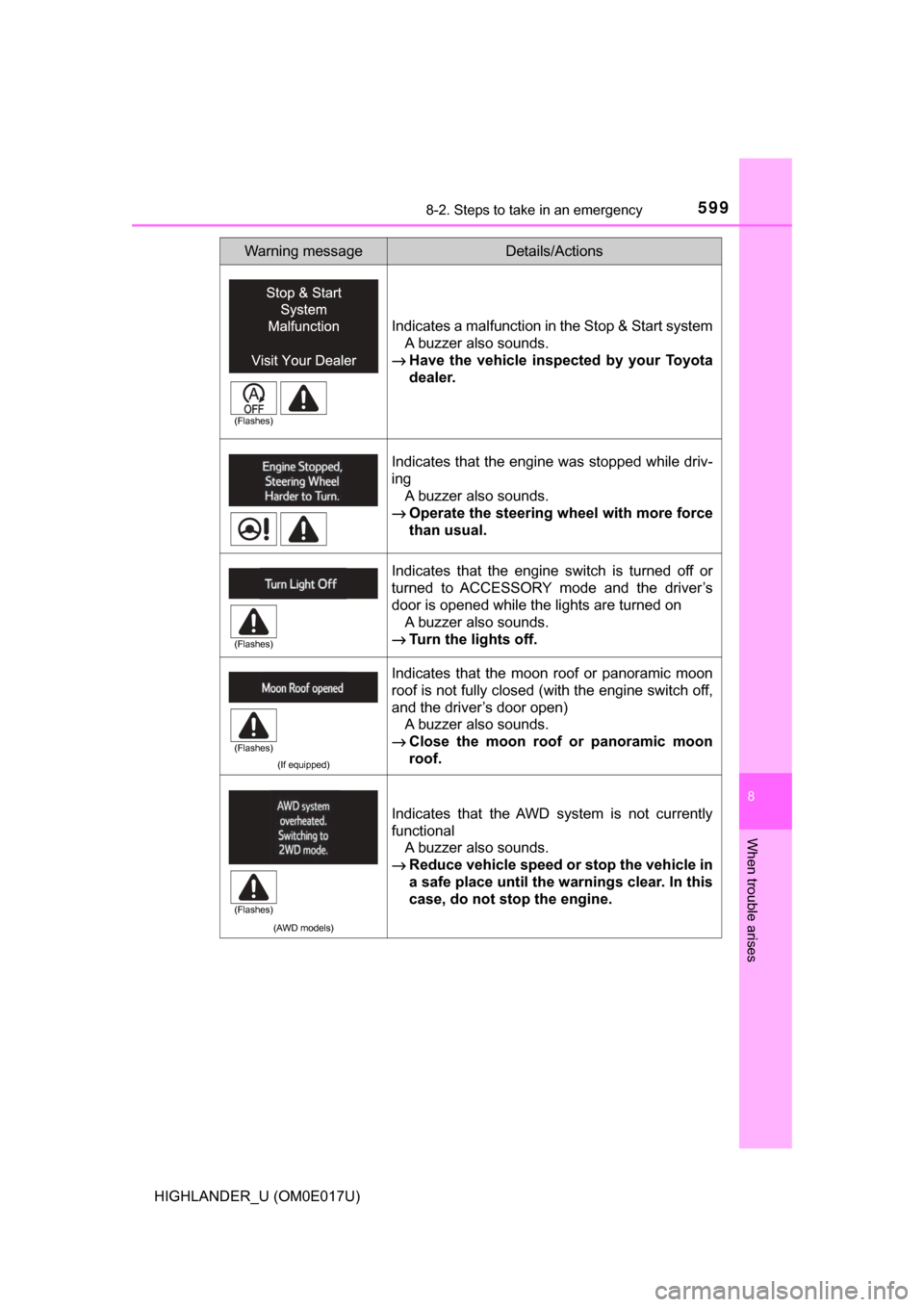Page 577 of 732
5778-2. Steps to take in an emergency
8
When trouble arises
HIGHLANDER_U (OM0E017U)
If you use chains or cables to tie
down your vehicle, the angles
shaded in black must be 45°.
Do not overly tighten the tie
downs or the vehicle may be dam-
aged.
WARNING
Observe the following precautions.
Failure to do so may result in death or serious injury.
■ When towing the vehicle
2WD models: Be sure to transport the
vehicle with the front wheels raised or
with all four wheels raised off the ground.
If the vehicle is towed with the front
wheels contacting the ground, the drive-
train and related parts may be damaged.
AWD models: Be sure to transport the
vehicle with all four wheels raised off the
ground. If the vehicle is towed with the
tires contacting the ground, the drivetrain
or related parts may be damaged, the
vehicle may fly off the truck.
Page 578 of 732

5788-2. Steps to take in an emergency
HIGHLANDER_U (OM0E017U)
NOTICE
■To prevent damage to the vehicle when towing using a wheel-lift type
truck
● Vehicles without a smart key system: Do not tow the vehicle from the rear
when the engine switch is in the “LOCK” position or the key is removed.
The steering lock mechanism is not strong enough to hold the front wheels
straight.
● Vehicles with a smart key system: Do not tow the vehicle from the rear
when the engine switch is off.
The steering lock mechanism is not strong enough to hold the front wheels
straight.
● When raising the vehicle, ensure adequate ground clearance for towing at
the opposite end of the raised vehicle. Without adequate clearance, the
vehicle could be damaged while being towed.
■ To prevent damage to the vehicle wh en towing with a sling-type truck
Do not tow with a sling-type truck, either from the front or rear.
■ Recreational towing (beh ind motor home, etc.)
Never dinghy tow your vehicle to prevent
causing serious damage to the Dynamic
Torque Control AWD system (AWD mod-
els) and transmission. (→P. 217)
Page 588 of 732

5888-2. Steps to take in an emergency
HIGHLANDER_U (OM0E017U)
WARNING
■If both the ABS and the brake system warning lights remain on
Stop your vehicle in a safe place immediately and contact your Toyota
dealer. The vehicle will become extremely unstable during braking, and the
ABS system may fail, which could cause an accident resulting in death or
serious injury.
■ When the electric power steerin g system warning light comes on
The steering wheel may become extremely heavy.
When steering wheel operations are heavier than usual, grip the steering
wheel firmly and operate it using more force than usual.
■
If the tire pressure warning light comes on
Be sure to observe the following precautions. Failure to do so could
cause a loss of vehicle control and result in death or serious injury.
●Stop your vehicle in a safe place as soon as possible. Adjust the tire
inflation pressure immediately.
●If the tire pressure warning light co mes on even after tire inflation pres-
sure adjustment, it is probable that you have a flat tire. Check the tires.
If a tire is flat, change it with the spare tire and have the flat tire
repaired by the nearest Toyota dealer.
●Avoid abrupt maneuvering and braking. If the vehicle tires deteriorate,
you could lose control of the steering wheel or the brakes.
■If a blowout or sudden air leakage should occur
The tire pressure warning system may not activate immediately.
Page 589 of 732

5898-2. Steps to take in an emergency
8
When trouble arises
HIGHLANDER_U (OM0E017U)
WARNING
■Maintenance of the tires
Each tire, including the spare (if provided), should be checked monthly
when cold and inflated to the inflation pressure recommended by the
vehicle manufacturer on the vehicle placard or tire inflation pressure
label (tire and load information label). (If your vehicle has tires of a dif-
ferent size than the size indicated on the vehicle placard or tire inflation
pressure label [tire and load information label], you should determine
the proper tire inflation pressure for those tires.)
As an added safety feature, your vehicle has been equipped with a tire
pressure monitoring system (TPMS-ti re pressure warning system) that
illuminates a low tire pre ssure telltale (tire pressure warning light) when
one or more of your tires is significantly under-inflated. Accordingly,
when the low tire pressure telltale (tire pressure warning light) illumi-
nates, you should stop and check your tires as soon as possible, and
inflate them to the proper pressure. Driving on a significantly under-
inflated tire causes the tire to overheat and can lead to tire failure.
Under-inflation also reduces fuel effi ciency and tire tread life, and may
affect the vehicle’s hand ling and stopping ability.
Please note that the TPMS (tire pressure warning system) is not a sub-
stitute for proper ti re maintenance, and it is the driver’s responsibility to
maintain correct tire pressure, even if under-inflation has not reached
the level to trigger illumination of the TPMS low tire pressure telltale (tire
pressure warning light).
Your vehicle has also been equipped with a TPMS (tire pressure warn-
ing system) malfunction indicator to indicate when the system is not
operating properly. The TPMS (tire pressure warning system) malfunc-
tion indicator is combined with the lo w tire pressure telltale (tire pressure
warning light). When the system detects a malfunction, the telltale will
flash for approximately one minute and then remain continuously illumi-
nated. This sequence w ill continue upon subsequ ent vehicle start-ups
as long as the malfunction exists. When the malfunction indicator is illu-
minated, the system may not be able to detect or signal low tire pres-
sure as intended.
TPMS (tire pressure warning system) malfunctions may occur for a vari-
ety of reasons, including the installation of replacement or alternate tires
or wheels on the vehicle that prevent the TPMS (tire pressure warning
system) from functioning properly. Always check the TPMS (tire pres-
sure warning system) malfunction te lltale after replacing one or more
tires or wheels on your vehicle to ensure that the replacement or alter-
nate tires and wheels allow the TPMS (tire pressure warning system) to
continue to function properly.
Page 594 of 732
5948-2. Steps to take in an emergency
HIGHLANDER_U (OM0E017U)
(If equipped)
Indicates that an intuitive parking assist-sensor is
dirty or covered with iceA buzzer also sounds.
→ Clean the sensor.
Indicates a malfunction in the EPS (Electric
Power Steering) system
A buzzer also sounds.
→ Have the vehicle inspect ed by your Toyota
dealer.
Indicates that the vehicle is being driven at 3 mph (5
km/h) or more with the parking brake still engaged
A buzzer also sounds.
→ Release the parking brake.
Indicates that the LDA (Lane Departure Alert with
steering control) system has determined that the
driver does not have their hands on the steering
wheel while the steering control function is on
If the system continues to determine that the
driver does not have his hands on the steering
wheel, comes on and a buzzer also
sounds.
→ Firmly hold the steering wheel.
Warning messageDetails/Actions
(U.S.A.) (Canada) (Flashes)
Page 599 of 732

5998-2. Steps to take in an emergency
8
When trouble arises
HIGHLANDER_U (OM0E017U)
Indicates a malfunction in the Stop & Start systemA buzzer also sounds.
→ Have the vehicle inspect ed by your Toyota
dealer.
Indicates that the engine was stopped while driv-
ing A buzzer also sounds.
→ Operate the steering wheel with more force
than usual.
Indicates that the engine switch is turned off or
turned to ACCESSORY mode and the driver’s
door is opened while the lights are turned on
A buzzer also sounds.
→ Turn the lights off.
(If equipped)
Indicates that the moon roof or panoramic moon
roof is not fully closed (with the engine switch off,
and the driver’s door open)
A buzzer also sounds.
→ Close the moon roof or panoramic moon
roof.
(AWD models)
Indicates that the AWD system is not currently
functional
A buzzer also sounds.
→ Reduce vehicle speed or stop the vehicle in
a safe place until the warnings clear. In this
case, do not stop the engine.
Warning messageDetails/Actions
(Flashes)
(Flashes)
(Flashes)
(Flashes)
Page 605 of 732
6058-2. Steps to take in an emergency
8
When trouble arises
HIGHLANDER_U (OM0E017U)
OnceContin-
uous
An attempt was made to lock
either front door by opening a
door and putting the inside lock
button into the lock position,
then closing the door with the
electronic key still inside the
vehicle.
→Retrieve the electronic key
from the vehicle and lock
the doors again.
Once⎯
The electronic key has a low
battery.
→Replace the electronic key
battery. ( →P. 549)
Once⎯
The steering lock could not be
released within 3 seconds of
the engine switch being
pressed.
→Press the engine switch
while depressing the brake
pedal and moving the
steering wheel left and
right.
Once⎯
Indicates a malfunction in the
smart key system
→Have the vehicle inspected
by your Toyota dealer.
Interior
buzzerExterior buzzerWarning messageDetails/Actions
(Flashes)
(Flashes)
(Flashes)
Page 608 of 732
6088-2. Steps to take in an emergency
HIGHLANDER_U (OM0E017U)
●Stop the vehicle in a safe pl ace on a hard, flat surface.
● Set the parking brake.
● Shift the shift lever to P.
● Stop the engine.
● Turn on the emergency flashers. ( →P. 572)
If you have a flat tire
Your vehicle is equipped with a spare tire. The flat tire can be
replaced with the spare tire.
For details about tires: →P. 531
WARNING
■If you have a flat tire
Do not continue driving with a flat tire.
Driving even a short dist ance with a flat tire can damage the tire and the
wheel beyond repair, which could result in an accident.
Before jacking up the vehicle